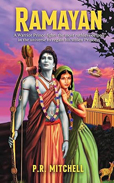
 |
In this epic—an ancient story from Eastern culture—the hero, Ram, spends his young years learning not only “the art of warfare” but also the virtues of leadership: bravery, compassion, lessons from his elders of wisdom, and other tangible and intangible attributes. Ram's wife, Sita, named for the Hindu goddess Devi Sita, lends her support and strength to the story. She and Ram, like couples in other epics with which Westerners may be familiar, such as Arthur and Guinevere, Troilus and Cressida, and Ulysses and Penelope, are depicted as partners who must face classic ordeals of worthiness, character, and punishment to become the people that they are meant to be and to do that which they must do.
Hindu beliefs and ancient cultural practices, as well as emotions and desires that are common to most people, guide the story. The work combines the classic elements of many epics, such as an aristocratic hero and heroine who must face many challenges. These include negotiating potential political and social traps, as well as their own insecurities and the inclinations of their egos. Ram, Sita, and their allies and antagonists must interact within environments full of the emotions and actions common to all manner of beings, whether human, spiritual, or supernatural.
The characters of the protagonists are shaped by their challenges, religious beliefs, social accommodations, backgrounds, and love and respect for each other. The messages in the story are common to many vintage tales. Mitchell's interpretation seeks to be accurate, educational, and enjoyable for a new audience. The story’s longevity and cultural diversity underline its universal appeal, revealing the situations and aspirations that are common in the human experience.